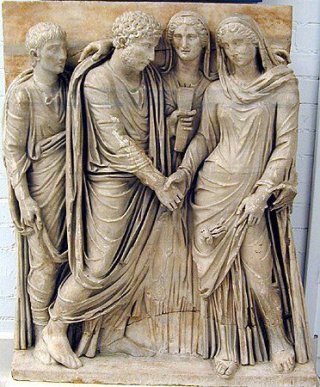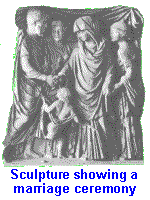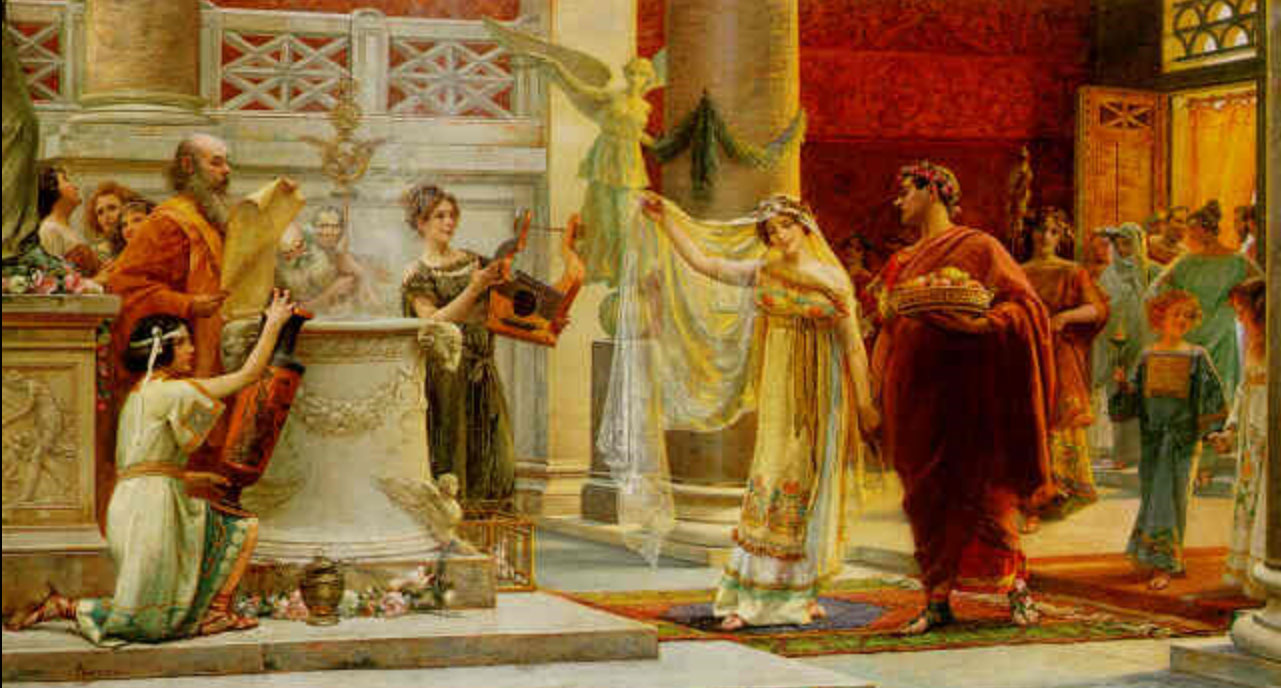Roman Marriage
Choosing a partner and the engagement
 In the Roman world, a boy became a man at the age of 15, yet he was allowed to marry when he just 14. The same age applied to the girls too. In wealthy families, the custom was for an arranged marriage, where the girl's father chose a man he believed was suitable for her. The choice was not usually based on character, more on the potential groom's family and their standing in society.
In the Roman world, a boy became a man at the age of 15, yet he was allowed to marry when he just 14. The same age applied to the girls too. In wealthy families, the custom was for an arranged marriage, where the girl's father chose a man he believed was suitable for her. The choice was not usually based on character, more on the potential groom's family and their standing in society.
As with most Roman traditions, there was a formal method of doing things, with written documentation to record the event. Marriage was no exception and even the couple's engagement was laid out in writing and signed by witnesses. Engagement rings were common even in Roman times and the girl would wear such a ring on the third finger of her left hand as a symbol, as is the case today.
 The engagement party sponsalia was again a formal affair with both families making speeches stressing the advantages of the relationship. The speech gave reasons for the union in terms of positive personal and spiritual enlightenment, and the true social and career motives were not mentioned.
The engagement party sponsalia was again a formal affair with both families making speeches stressing the advantages of the relationship. The speech gave reasons for the union in terms of positive personal and spiritual enlightenment, and the true social and career motives were not mentioned.
Engagements were not always seen through to the final marriage, and it was common for them to be broken off for any reason. Even senior political figures had multiple engagements before they finally settled down. Augustus was engaged three times before he married.
Preparations for the wedding
Over the years, many dates in the Roman calendar were considered to be' bad luck days' as they had been linked with some disastrous occurrence in the Roman Empire. The wedding day was chosen with care to avoid such days, in case it brought ill fortune upon the couple. The most favourable time was the latter half of June, when most weddings took place.
|
|
Today in Britain, there are a limited number of variations of the wedding ceremony, but the Romans had a variety of ceremonies to choose from. In the more traditional, which was long winded, elaborate and involved the performing of many rituals, the bride passed into the groom's family and came under the influence of her new husband. As time went on, and women became more liberated, taking amore active role in Roman society, the ceremonies became less rigorous. The later weddings allowed the bride to remain in the power of her own family. By doing this, she became more independent.
On the morning of the wedding, the house was decked in garlands and wreaths to show anyone in sight that a special event was taking place. Ribbons were hung from every part of the house and a great display of arranging all these items ensured the family received maximum attention.
The bride gave the personal belongings from her childhood to the family and removed her current child clothes in favour of her bridal gown. Her hair was styled. The fashion was for the bride to have her hair, separated into six locks, held in place by ribbons that made her hair into a cone shape. Her headdress was made from flowers and sat on her head to either side and to the back of her cone shaped hairstyle. The veil was flame coloured and the bridal gown w
The wedding ceremony
 This section is a description of an ortodox wedding, although there were many variations.
This section is a description of an ortodox wedding, although there were many variations.
Once everything was ready and the guests had assembled, the wedding ceremony began. The first action was a sacrifice of an animal to appease the gods and draw their attention to the proceedings. Then the couple would sign the marriage contract, which would then be signed by witnesses.
The bride would them be led towards the altar by her bridesmaid pronuba. The bride and groom then joined their right hands, which was considered to be a most significant act in the ceremony. (As shown right)

When the process of giving their vows was completed, then the wedding reception began. The celebrations continued well into the late hours when much food and wine was consumed.
When it was thought appropriate, the husband would try to lead his wife to his house, whereupon she had to put on a display of pretending to resist his actions. The couple were followed by torch bearers and three flute players. The guests and any passers by would shout greetings and good wishes. The husband would scatter coins around him which the young children would gather up. On reaching his house, the bride would carry out her last duty of the wedding by smearimng fat on the doorposts, after which her husband would pick her up and carry her over the threshold.
This was the arrangement for the first marriage. If the couple separated and one of them remarried, the ceremony was distincly low key in comparrison with the one described here.
The children of the marriage
The Roman marriage contract stated that the reason for the marriage was to fulfil the couple's desire to unite and have children.
The naimg of the children was traditional and adhered to most rigourously. If the child was a boy, then he was given three names
His first name : His personal name (Marcus)
His second name : The clan name (Tullius)
His third name : His family name (Cicero)
The example above is, of course, why Marcus Tullius Cicero was so named.
This was the case if the child was a boy and came from nobility, and any girls produced were only given a personal and clan name.




















